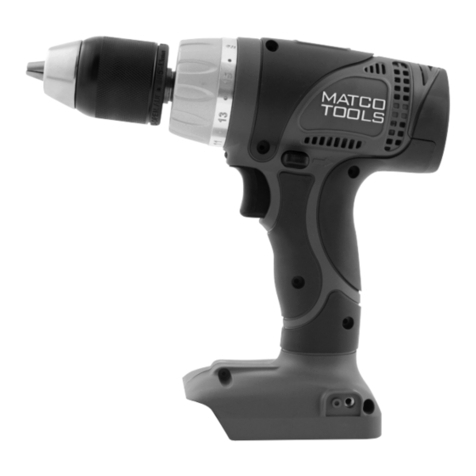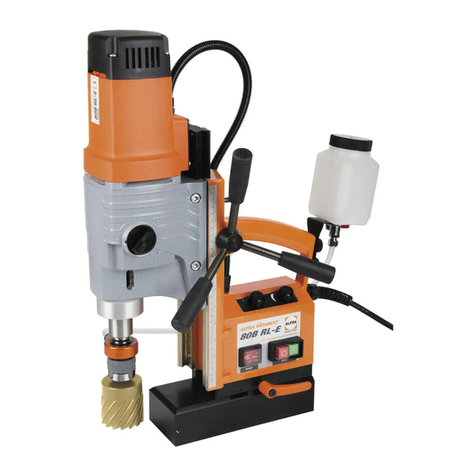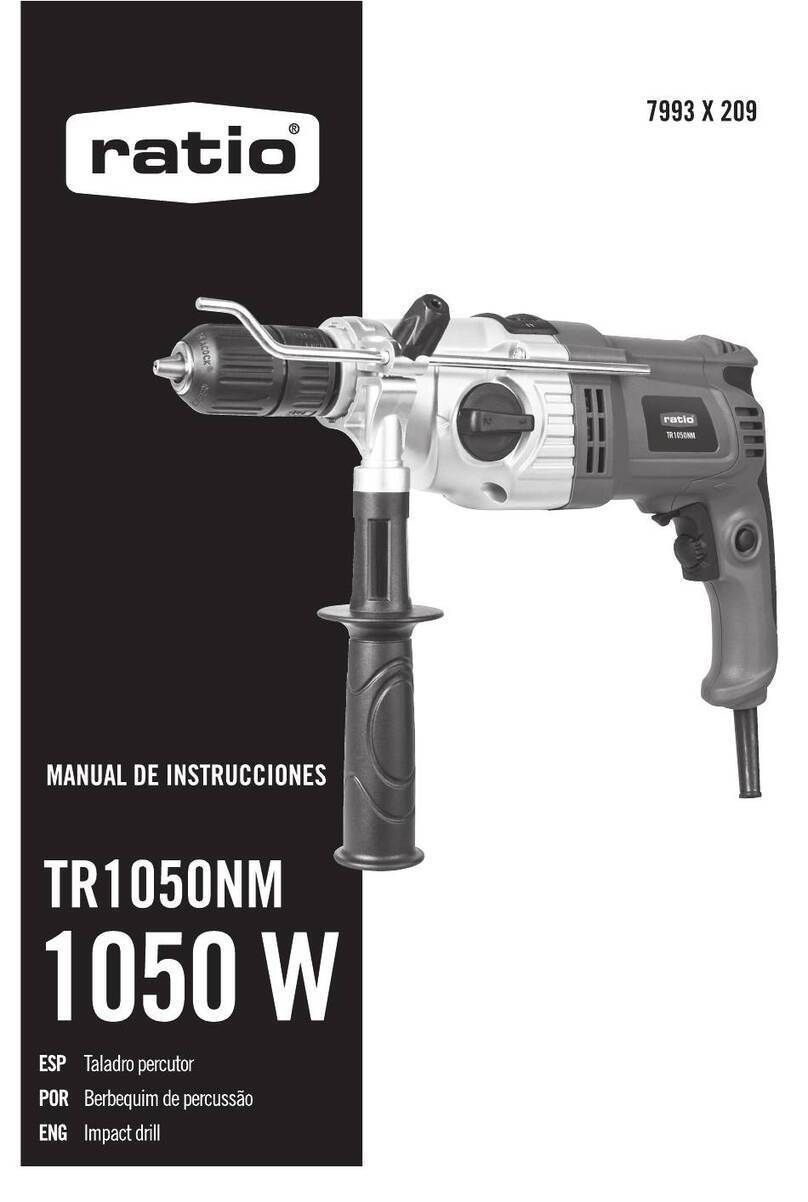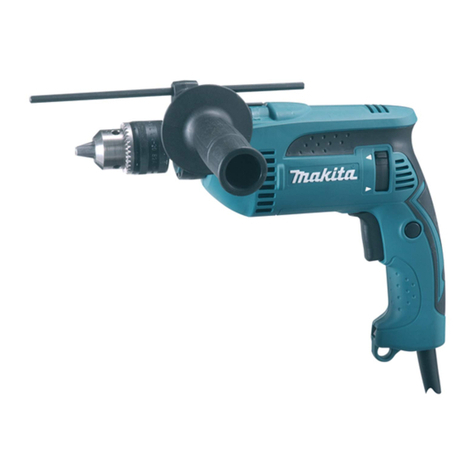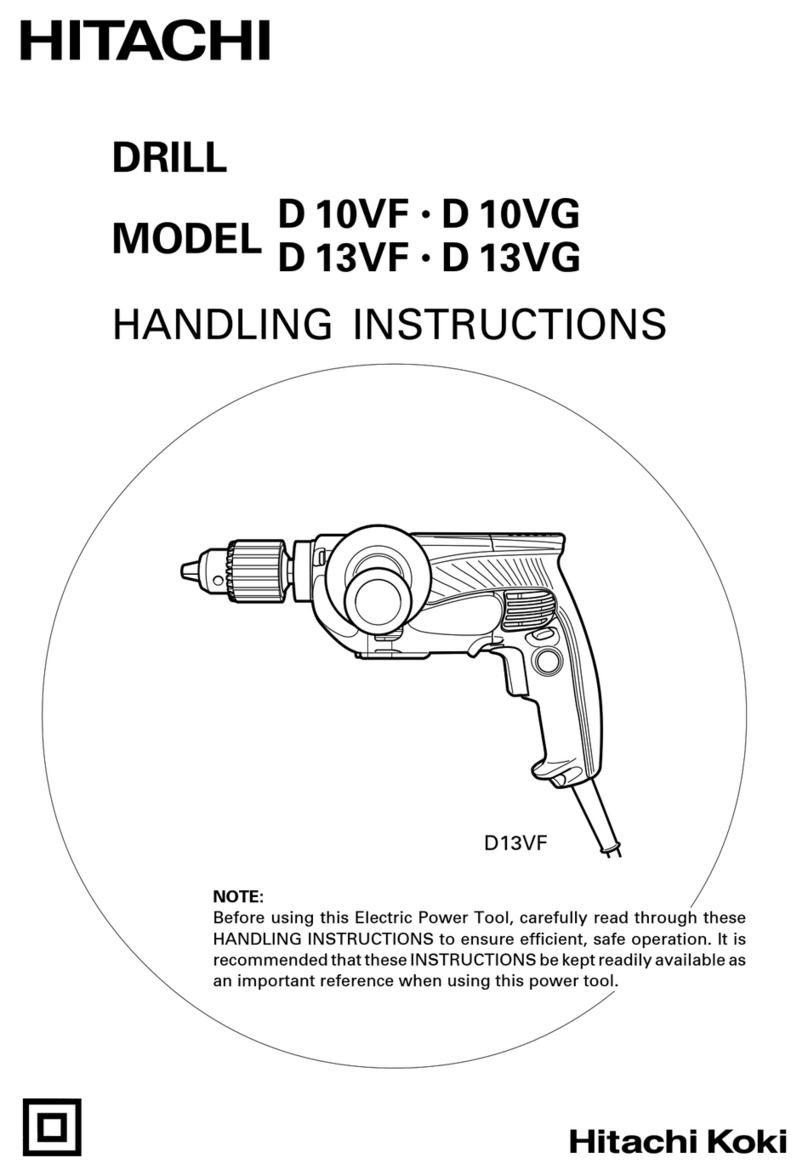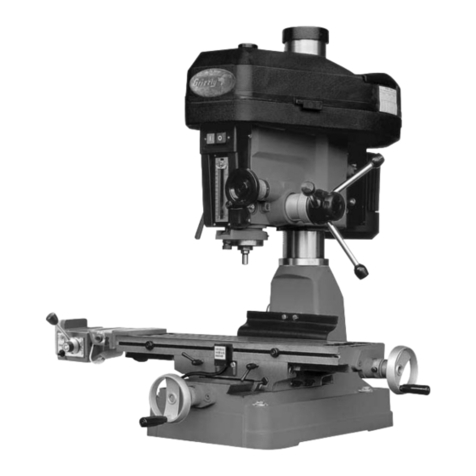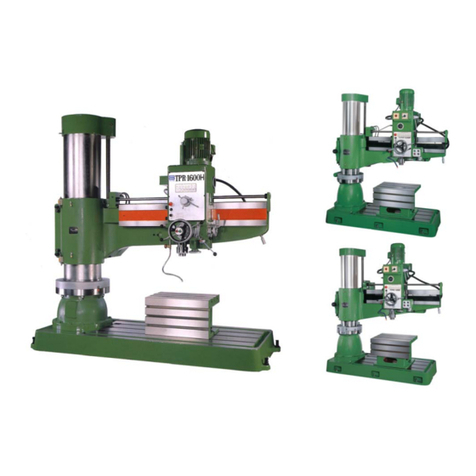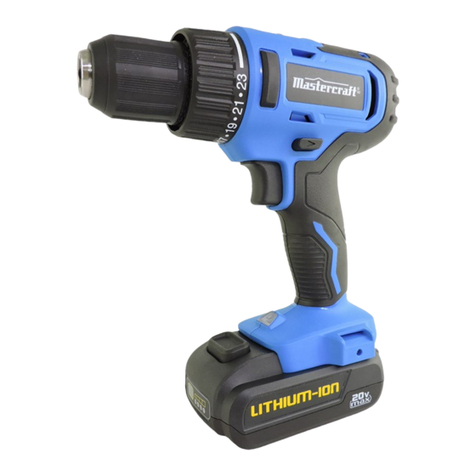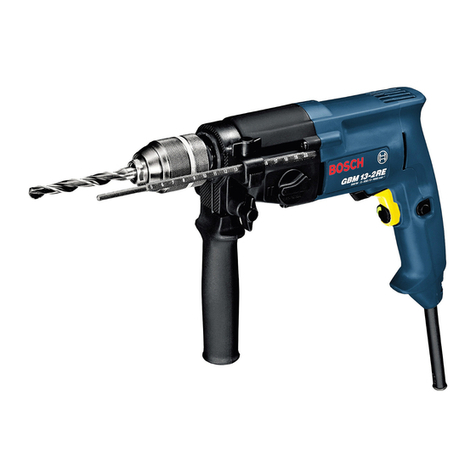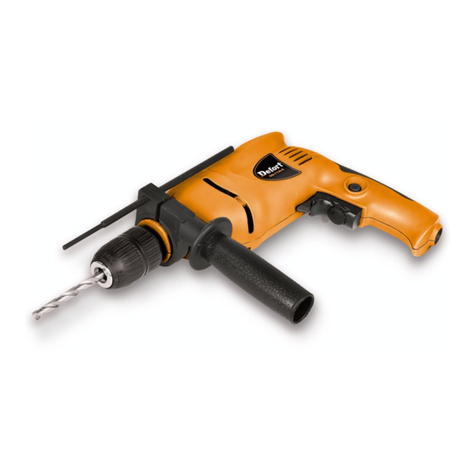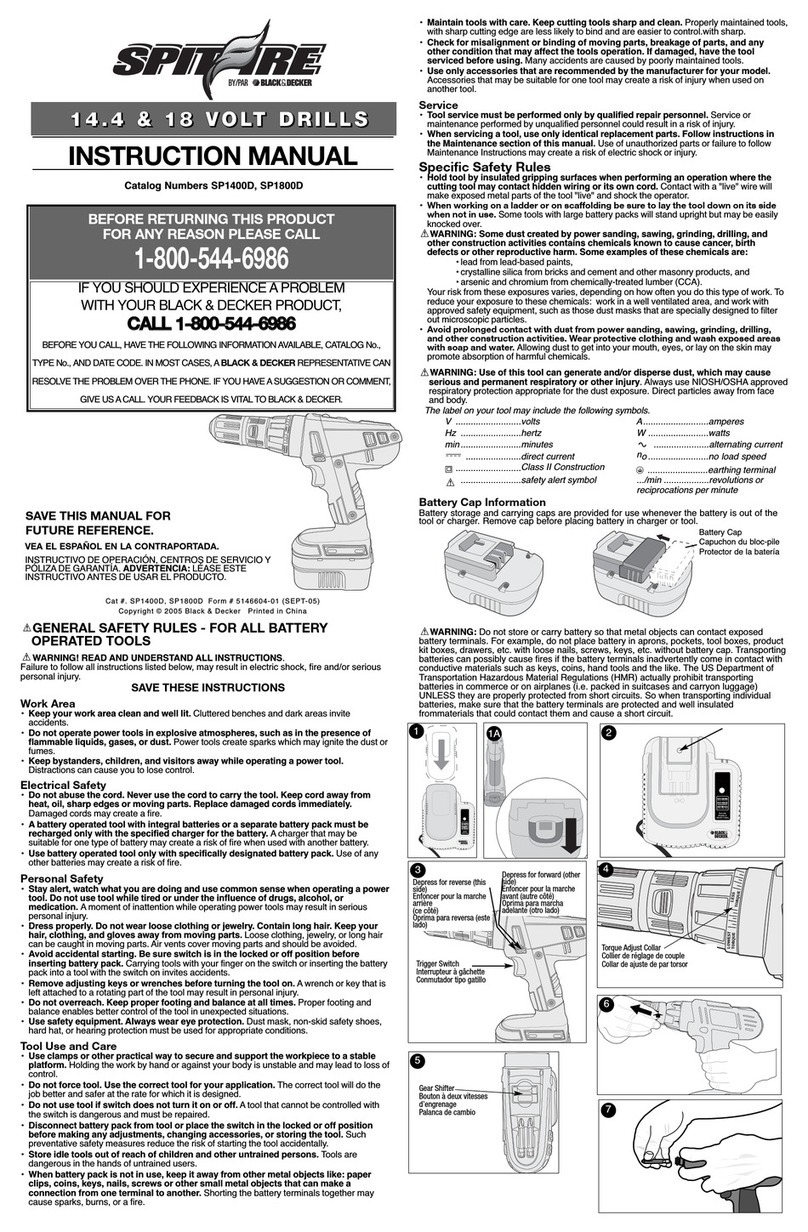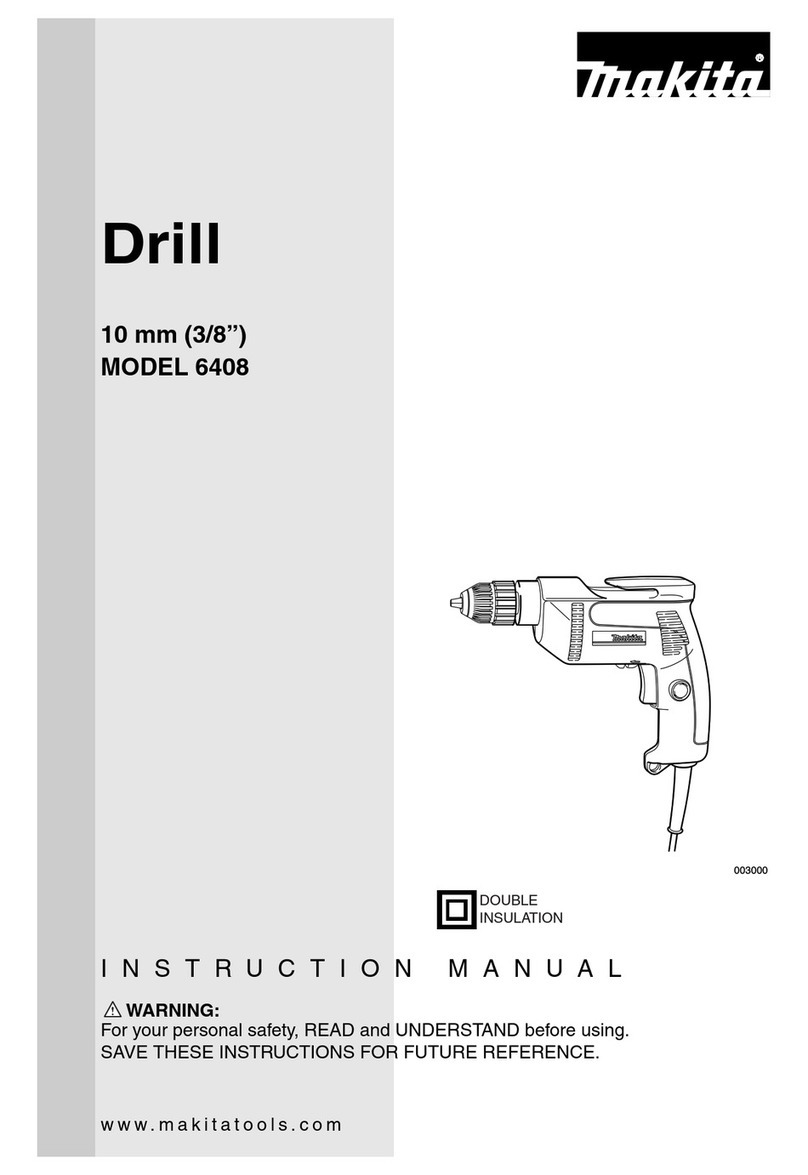SET-A Makina TIGER MOBIL DACH Manual

TIGER MOBIL
DACH
Maintenance and Instructions Manual

1
WARNING
SET-A Makina
This manual contains important information on safety. Before carrying out any handling or use
operation consult this use and maintenance manual.
This manual contains copyright reserved information. All rights reserved.
Any form of reproduction, adaptation, or translation without the previous written consent of
SET-A Makina is forbidden.
SET-A Makina is not liable for direct or indirect damage to persons or objects due to the use of
this manual or machine in conditions different than those prescribed or which do not guarantee
the operator's safety.
All data contained in this manual are indicative and not binding, given that SET-A Makina
reserves the right to modem or vary its machines without any previous warning.
General Information
Manual content and use
Keep this manual in a dry and safe place for future reference, so that it is not ruined and is always
available for consultation.
This manual cannot replace the user's experience but it does supply all the information for correct
machine use.
If you need copies or up-dates, exclusively contact the SET-A Makina, which will supply indications on
the matter and solve any problems.

2
CONTENTS
CONTENTS ............................................................................................................................................... 2
PRESENTATION........................................................................................................................................ 3
GENERAL NOTES ON DELIVERY................................................................................................................ 4
Guarantee............................................................................................................................................ 4
Parts subject to wear are not covered by the guarantee. .................................................................. 4
Modifications To The Machine............................................................................................................ 4
Identification Of Spare Parts ............................................................................................................... 4
TECHNICAL DESCRIPTION ........................................................................................................................ 5
TECHNICAL CHARACTERISTICS ................................................................................................................ 6
SAFETY ..................................................................................................................................................... 7
General Information Concerning Safety.............................................................................................. 7
Safety Prescriptions............................................................................................................................. 7
VERIFICATIONS AND ADJUSTMENT....................................................................................................... 10
USING THE MACHINE ............................................................................................................................ 11
Fitting the down the hole hammer (DTH) ......................................................................................... 11
Using the machine............................................................................................................................. 11
EXTENSION ROD JOINTING.................................................................................................................... 12
At the end of the drilling limit: .......................................................................................................... 12
ROD AND HAMMER RECOVERING......................................................................................................... 13
MACHINE STOPPING AND REMOVAL ..................................................Hata! Yer işareti tanımlanmamış.
MAINTENANCE ...................................................................................................................................... 14
Adding Oil .......................................................................................................................................... 14
Periodical Controls ............................................................................................................................ 14
HAMMER BIT SHARPENING................................................................................................................... 15
Reconstructing the tooth support..................................................................................................... 16
AIR RECIEVER (OPTIONAL)..................................................................................................................... 17
TECHNICAL DATA............................................................................................................................... 17
PROBLEM SOLUTION SUGGESTIONS..................................................................................................... 18
APPENDIX I ............................................................................................................................................ 19
APPENDIX II ........................................................................................................................................... 20

3
PRESENTATION
It is a modern, simple and powerful drilling machine which is powered by pressurized air. In engineering
applications, it is successfully used in drilling holes Ø76 or Ø90mm, for different purposes.
•Compressed air is enough to drill holes with the Tiger Mobil DACH.
•No need for different power sources like hydraulic power unit, electricity etc.
•Allows you to easily drill holes; simple, lightweight and powerful drilling machine.
•It is a safe driller that keeps work safety at the top level.
•The machine is equipped with a piston type pneumatic air motor for rotation, a vein type
pneumatic air motor that allows the tool to move up and down via a chain and a DTH hammer.
•Horizontal, vertical and angle hole drilling operations can be achieved easily and successfully.
•Without deviation, the recommended maximum drilling depth in vertical holes is 20-25 m.
•High drilling speed: (granite: 10-15 cm/min; limestone - marble: 20-25 cm/min).
•Assembly and disassembly are easy and can be carried and moved very easily.
•Automatic lubricator with the central lubricating system.

4
GENERAL NOTES ON DELIVERY
On receipt of the machine, open the package and check that:
•The equipment is not damaged.
•In the case of transport damage, inform the forwarder and / or the transport insurance company
In a detailed way, immediately on delivery.
•The supply corresponds to the order specifications
If any pieces are missing, immediately inform the SET-A MAKINA within 8 days of receipt.
Guarantee
The machine is supplied and guaranteed to be free from fabrication faults or defective material for a
period of 1 year from the date on the transport document.
This guarantee, concerning faults and defects due to material, manufacturing and processing, is valid on
condition of reporting them within 8 days time after the relative identification.
Parts proved to be defective will be reaired or replaced, at the discretion of the SET-A MAKINA, on
condition that the said defect does not depend on failure to observe the use and maintenance
instructions, bad or unsuitable use of the equipment or on normal wear.
The parts to be replaced or repaired will be made available ex-our workshop.
The user shall sustain the shipment and transport costs, plus those for the labour, travel and board, if
the repair should necessitate the presence of one of our technicians.
Parts subject to wear are not covered by the guarantee.
Modifications To The Machine
SET-A MAKİNA reserves the right to make all necessary modifications to the machines it manufactures
without any prior notice.
Machine identification
The machine is identified by the number indicated on the card.
Identification Of Spare Parts
When requesting spare parts, always indicate the machine's serial number found on the test card and
the no. of the required part taken from the enclosed lists of spares.

5
TECHNICAL DESCRIPTION
MOD. TIGER MOBIL DACH SERIAL No. MD___________________
Pneumatic drill comprised of a column supporting the rotating head with an attachment for the down the
hole hammer. The rotating head can be supplied with a thread for rods with a cylindrical, male fitting
(RD 50) or a conical, female fitting (API 2” 3/8).
Rotating head advance via a chain driven by a pneumatic gear motor.
The machine is supplied as standard with:
•Support column (Appendix I page 23).
•Control unit with line lubricator (Appendix II page 19).
•2 wrenchs for unscrewing the rods.
•Drill steel 22x108 Ø40 400 mm L. for anchoring holes.
•Column anchoring chains (3 pcs, 3 m)
The following are available on request:
•1000 mm. drilling rods (39 in.) or 1500 mm. (59 in.) depending on column length.
•Down the hole hammer (DTH).
•1 wrench for hammer disengagement.
•Bit for down the hole hammer.
•Sharpener for hole bottom bit.
•Adapter from RD 50 to API 2” 3/8.
•Dust extractor.
•Air Receiver (see page 16).

6
TECHNICAL CHARACTERISTICS
kg
lbs
2200 mm (86”) column
55
122
2700 mm (106”) column
62
137
Control unit weight
33
73
Rotation head weight
36
80
Down the hole hammer weight (DTH)
25
55
Bit weight
5
11
1 m (39”) rod weight
11
25
1.5 m (59”) rod weight
14
31
Total weight - 2200mm column and chassis
290
638
Total weight - 2700mm column and chassis
297
653
Advance motor air consumption
800 Lt/min at 6 bar (29 cfm at 87 P.S.I.)
Rotating head air consumption
2000 Lt/min at 6 bar (73 cfm at 87 P.S.I.)
3" down the hole hammer air consumption
4000 Lt/min at 6 bar (146 cfm at 87 P.S.I.)
Total compressed air consumption
6800 Lt/min at 6 bar (219 cfm at 87 P.S.I.)
Lubricating oil consumption
1.5 Lt every 8 hours of work

7
SAFETY
General Information Concerning Safety
The design and manufacturing of this machine in conformity with the Machinery Safety Directive
2006/42/AT, 2006/95/AT LVD Directive, 2004/108/AT EMC Directive (specify relevant provisions and
other applicable directives, if any).
In particular, measures designed to prevent risks to operators were adopted during the design and
construction phases.
The complete documentation of the safety measures adopted is contained in the technical dossier
deposited at the offices of the SET-A Makina.
For some risks it was not possible to find solutions at the design level. In these cases, this manual
indicates the safety prescriptions to adopt to operate in the safest way.
WARNING: SET-A Makina recommends complying with the instructions, procedures and
recommendations of this manual, to adopt all precautions suggest by the technique and to
comply with the accident prevention regulations in force.
Safety Prescriptions
•The installation, maintenance, and use of the machine is reserved to specialised staff.
•Before performing any cleaning or maintenance intervention, check that the power supply is
disconnected.
•Do not remove the fixed protections of the machine protecting the mobile elements.
•Do not put your hands in the pairs where there is a danger of being crushed or trapped.
•The operator should stay by the control group in the most distant and protected position.
•When working and performing control operations the operator must always position himself
behind the control group.
•When the machine or its parts are handled it must idle and the power supply must be
disconnected. This must be performed by specialized staff with the appropriate tools.
•If it is necessary to replace machine components, exclusively use original spare parts.

8
COLUMN ANCHORING WITH CHAINS
1. Make 3 - 34 mm holes 20 cm ( 8 inc) deep.
2. Fix the chains (4) to the rings (1) of the column (3) using the hooks (clevises) (2).
3. Slacken the tighteners (5).
4. Fix the chains (4) to the ground using the special anchoring pins (6-7).
5. Use the tighteners (5) to tighten the chains equally.
1. Chain fixing rings
2. Hooks (clevises)
3. Column
4. Chains
5. Tightener
6. Pin
7. Plug

9
AIR CONNECTIONS
1. Direct the control unit to the most suitable and safe
position for performing the operations.
2. Close the compressor 12 (Appendix II) entry valve
and the supply valve for the down the hole hammer
13 (Appendix II) as in fig.4
3. Connect the feeding hose 14 (Appendix II) of the
down the hole hammer to the corresponding fitting
on the output group of the rotating head 6 (Appendix
I).
4. Connect the head rotation feeding hoses 15
(Appendix II) - right and left - to their corresponding
fittings 8 (Appendix I) on the rotating head.
5. Connect the up and down hoses 16 (Appendix III) to
the corresponding fittings 10 (Appendix I).
6. Position the distribution levers for rotation 1
(Appendix II) and advance 2 (Appendix II) to closed
or rest (central position) 0 (zero).
7. Connect the main feeding hose 17 (Appendix II) of
the supply compressor to the corresponding valve
12 (Appendix II) on the control unit.
For the air supply, use a hose no smaller than 1” 1/4.
ROTATION
ADVANCE
A –Anticlockwise (rod unscrewing)
A –up (backwards)
0 –Rest
0 –Rest
B –Clockwise (drilling)
B –Down
Figure 4
Figure 5

10
VERIFICATIONS AND ADJUSTMENT
WARNING: if the machine is new or has been idle for a long period, pour some oil directly into
the drill supply pipes for more rapid initial lubrication.
•Check that there is a sufficient amount of lubricating oil in the tank 8 (Appendix II) of the
lubricator. If not consult page “Maintenance: Adding Oil”.
•Make certain that the compressor supplies enough pressure to position the gauge needle 3
(Appendix II) in the green field of the dial corresponding to 5,5 - 7 bar.
WARNING: this pressure should be kept constantly in the green area during the drill (ideal
pressure 6 bar).
Regulate the passage of the correct amount of oil using the adjustment screw (Appendix II, pos.10).
RECOMMENDED: For proper lubrication, disconnect the feed hose and supply compressed air.
The air should be slightly oily (check with the palm of the hand).

11
USING THE MACHINE
WARNING: before using the machine, check that it is well anchored to the ground and that all
the bolts and air hoses are correctly tightened.
Fitting the down the hole hammer (DTH)
1. The machine is generally supplied with the down the hole hammer fitted to the rotating
head.
2. The same hammer, has the drilling bit fitted to its bottom end. The type of bit is the one
requested by the customer, or the most suitable one for the material to be drilld.
3. To fit a down the hole hammer not supplied with the machine, strictly follow the
instructions of the company that supplied the hammer.
4. The down the hole hammer is screwed on in a clockwise direction to the output group
of the rotating head. Before fitting, make sure that the threaded fitting is the same as
the one on the rotating head: cylindrical RD50 or API Regular 2" 3/8 conical.
5. The down the hole hammer must be tightened with the special wrenchs supplied (see
"Extension rod joint" page 12).
Using the machine
1. Supply the control unit by opening the valve 12 (Appendix II).
2. Check that the gauge needle 3 (Appendix II) oscillates within the green
field on the dial.
3. Approach the hammer bit to the surface to be drilled. This is performed
by lowering the distribution lever 2 (Appendix II) towards position B of fig.6.
The distributor commands the advance of the rotating head - down the hole
hammer group.
4. Open the valve 13 and rotate and percuss the hammer by lowering
distribution lever 1 (Appendix II) towards position B of fig.6. The hammer bit
rotates clockwise. Release the stopper 6 on the pressure regulation 5 (fig.7)
by unscrewing it anti-clockwise.
5. Regulate the head rotation using the pressure regulator 4 by screwing
and/or unscrewing the knob 5 (fig.7).
6. Drilling has now started.
WARNING: advance only serves to keep the bit close
to the rock to be drilld, and not to keep it pressed
against the rock itself.
Figure 6
Figure 7

12
EXTENSION ROD JOINTING
At the end of the drilling limit:
1. Block the advance, rotation and percussion by closing the respective distributors (Appendix II, pos. 1,
pos 2, pos 13).
2. Recover the play of the carriage springs 3 (Appendix I) by slightly lifting up the rotating head (fig.8
and fig.9).
3. Insert the wrench supplied into the seat (a) of the output group
and turn it against the column. This prevents the reducer from
advancing and the rotating head from
becoming damaged by counter-blows
while changing the rods. (fig.10).
4. Insert the wrench supplied into the
seat (b) of the hammer or rod and
keeping the wrench contrasted in (a)
against the column, release the
hammer or rod by applying a few
hammer blows to the wrench in the
seat (b) (fig.10).
5. Remove the wrenchs, rotate the rotating
head in an anticlockwise direction (pos. A of
distributor 1 - fig.5 page 9) and unscrew the
hammer or the rod. Position the rotating
head high on the column, almost as far as it
will go.
6. Manually screw the extension rod onto the hammer or possibly onto the other
rod found in the hole (fig.11).
7. Advance the rotation head and make it rotate clockwise (pos. B of distributor 1 -
fig.5 pag.9) and screw it to the rod or the hammer.
8. After checking that the rod has been screwed both to the head and the hammer
(or possibly to the other rod still found in the drill), start drilling again.
For more joints, repeat the operations described.
WARNING: never unscrew the rods or the hammer with just the force of the rotation head. Keep
the control unit as far away as possible from the column to prevent accidental manouvres.
Figure 8
Figure 9
Figure 10
Figure 11

13
ROD AND HAMMER RECOVERING
1. Block the advance, rotation and percussion by closing the respective distributors and valve 2, 1,
13 Appendix III.
2. Position the rotating head high on the column almost as far as it will go.
3. Insert the wrench supplied into the seat (d) of the rod which finds
itself in the hole and make it rest on the rod guide. In the case of
vertical drilling, this wrench serves to prevent the rods from falling
into the drill at the moment they are unscrewed from the rotating
head.
4. Insert the wrench supplied into the seat (a) on the rotating head
and wedge it against the column.
5. Insert the wrench supplied into the seat (b)
6. Hit the wrench inserted in seat (b) with a hammer and release the
rod, by making it rotate in a clockwise direction.
7. Remove the wrenchs from seats (a) and (b), rotate the head and
unscrew it from the rod.
8. Position the rotating head high up on the column to almost as far
as it will go.
9. Insert the wrench into seat (c), wedge the wrench in seat (d)
against the column; hit the wrench in seat (c) with a hammer to
release the rod and then unscrew it.
10. We have now removed the 1st rod.
11. Approach the rotation head of the 2nd rod which is still found in
the drill.
12. Screw the head to the rod to then make it rise up pulling the
rod with it.
13. By repeating the procedure described, we recover the other
rods and the hammer.
WARNING: never try to unscrew the rods or the hammer with the
force of the rotation head alone. Keep the control unit as far away
from the column as possible with the purpose of avoiding any
accidental manouvres.
Figure 12
Figure 13

14
MAINTENANCE
Adding Oil
WARNING: before proceeding with the oil addition operations, stop the machine, close the
compressor air supply and discharge any air remaining in the control panel by opening valve 13
Appendix II. This is important because it is dangerous to remove the plug or the lubricator tank
with the control panel under pressure.
To add oil to the line lubricator, with the machine at a standstill and not powered up, unscrew the screw
plug 11 Appendix II and add oil, or directly release the tank by pressing button 19 and by rotating the
lock ring.
If the long idle periods are foreseen, or if the machine is made to operate after being idle for a long time,
pour oil directly into the supply inlets of the rotating head and the advance motor and rotate them slowly
for a few turns to lubricate the mechanical parts well.
Oil to use:
•Mobil ALMO 527
•Petrol Ofisi ROCKDRILL 100
•Shell TORCULA 100
Grease to use:
•Petrol Ofisi SUPERGRES EP00
•Shell GADUS 00
•Mobil LUX EP00
Periodical Controls
Daily: Check the oil level.
Check that all the bolts and the air hoses are suitably tightened
Check the chain tension and adjust it with the tightener 14 (Appendix I) if necessary check the
integrity and wear of the bit.
Weekly: grease the chain pinion 2 (Appendix I) of the advance group using the greasers provided (Part.
A Appendix I). Use the recommended grease or an equivalent one.
Check that the neck of the sphere is free from cracks. If you notice any cracks, suspend machine use.

15
Figure 15a
Figure 15b
Figure 16a
Figure 16b
Figure 16c
Figure 17a
Figure 17b
Figure 17c
HAMMER BIT SHARPENING
In use, the down the hole hammer bit wears
changing the shape of the teeth (Fig.15a) and
that of the teeth support (Fig.15b).
It is therefore necessary to regenerate both
the tooth shape and that of the teeth support.
Using the special sharpening machine, (optional) with a suitable
cylindrical tool of adequate dimensions, remove the right
amount of material from the teeth support to return the teeth to
a suitable height.
(Fig.16a-b-c).
Change the tool on the sharpener with one with a semi-
spherical profile and reconstruct the tooth's profile in
(Fig.17a-b-c).

16
Figure 19
Reconstructing the tooth support
Concerning the tooth support, it is also necessary to reconstruct the side because its original shape is
lost through wear, tending to become straight, chamfered and rounded. (Fig.18).
During drilling, the bit teeth wear leaving the tooth support exposed to a greater diameter.
Using a lathe or a lapping grinder, it is necessary to remove
material from the sides of the teeth support to restore the initial
inclination, without which it is not possible to work correctly.
(Fig.19).
NOTES:
The indications given, mainly concern tools for working granite, which given the hardness of this
material are subject to greater wear. It is therefore nece ssary to resharpen them more frequently.
Tools used for softer materials, such as marble for example, wear much less and require re-sharpening
more rarely. The procedure is anyway the same.
Figure 18

17
AIR RECIEVER (OPTIONAL)
1. Connect the condensation separator to the drilling machine (pos. 17 Appendix III) using the
rubber hose supplied (1.300 mm. long) screwed to the AIR OUTLET SIDE.
2. On the AIR INPUT side, open the air supply ball valve from the compressor.
3. From time to time, when the drilling machine is operating, slightly open the discharge valve (A)
to purge the condensed water. To prevent unnecessary air consumption, this valve must be
kept partially open only during drilling.
TECHNICAL DATA
Tank Lenght 500 mm (20”)
Tank Diameter 160 mm (6”)
Total Weight 17 kg (38 lb)

18
PROBLEM SOLUTION SUGGESTIONS
Problem
CAUSE
SOLUTION
Insufficient air pressure (needle
below the green field of the
gauge).
•Quantity of air generated by the
compressor insufficient.
•Small feeding hose section or
excessive feeding hose length.
•Replace the compressor with one with a
higher yield (air delivery rate).
•Replace the feeding hose with one with
a greater section and in proportion to
the length. We advise using a hose no
less than 1”1/4.
Low yield
•No lubrication
•Operating pressure insufficient.
•Down the hole hammer worn,
worn out or dirty.
•Worn bit.
•Check the lubrication of the down the
hole hammer.
•As above
•Clean the down the hole hammer.
Overhaul the down the hole hammer
•Sharpen the teeth
Advance cannot be regulated by
the pressure regulator
•Faulty pressure regulator.
•Retaining valve pos.20
(Appendix III) fault
•Advance feeding hoses inverted
pos.16(Appendix III)
•Change the pressure regulator
(Appendix III)
•Change the retaining valve 20
(Appendix III).
•Invert the advance feeding hoses 16
(Appendix III).
The advance motor does not turn.
•No lubrication
•Foreign material has entered the
blade rotation group.
•Check the lubrication
•Remove the motor upper cap and clean.
Check that the rotor and blades move
freely
The rotating head does not turn
•No lubrication
•Seizure of the piston of the
motor due to insufficient
lubrication.
•Motor piston breakage due to the
entry of water into the air hoses.
•Rotating distribution valve seized
due to insufficient lubrication or
because of the entry of foreign
objects (e.g. earth) into the air
hoses.
•Reduction gear breakage due to
incorrect rod jointing or
unscrewing actions without the
correct use of the wrenchs
supplied.
•Crushed rotation group due to
the accidental falling of the
column.
•Piston motor breakage, due to
exceeding the maximum air
pressure limit permitted: 6 bar
•Check the lubrication
•Replace the piston We also recommend
using the condensation separator.
•Replace the rotating valve.
•Replace the reduction gear.
•Replace the rotating head.
•Replace the pistons and other possibly
damaged mechanisms. Change the
compressor with one with low pressure
or use a control unit with a pressure
reducer.

19
APPENDIX I
1. Support column
2. Advance chain
3. Carriage
4. Rotating head
5. Rotating head output group
6. Hammer feeding hose
7. Hammer or rod fitting seat
8. Rotating head feeding hoses
9. Advance motor
10. Fast fittings of advance motor feeding hoses
11. Spherical joint
12. Rod guides
13. Arms for levelling screws
14. Chain tightener
15. Chain transmission
16. Head rapid release pins
17. Air discharge
Table of contents
